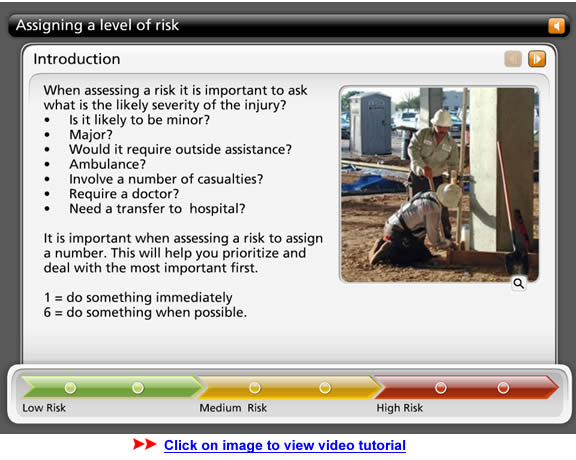Lesson 5: Hazards and risks
You have learnt that occupational health and safety legislation aims to prevent injuries and accidents in the workplace. Injuries and accidents are prevented when the workplace is free of hazards and risks.
What are Hazards and Risks
A hazard is anything that has the potential to cause injury or disease
A risk is the likelihood of a hazard resulting in an injury or disease.
Note: A hazard can exist without posing a risk.
There are two main types of hazards that can arise in the workplace.
1. Safety hazardsSafety hazards are any things that could result in injury — for example, broken bones, cuts, loss of eyesight. Accidents at work are generally the result of safety hazards. Examples of safety hazards are:
|
|
2. Health hazards
Health hazards are conditions in the workplace that may cause disease or illness. The hazards may be physical, chemical, biological or organisational. Health hazards are sometimes difficult to recognise because they may develop slowly and the symptoms resulting from exposure to a health hazard, can occur a long time after exposure.
Most, if not all, of these safety and health hazards can be eliminated or controlled by taking simple preventative measures.
Download a Text Alternative for this activity
Read: Recognizing hazards policy
Access the internet to research
Go to http://mindtools.com and select Stress Management. These articles will help you to manage the stress in your life
Go to this NSW address and play with the multimedia interactive tutorials http://workcover.cadre.com.au/index_1st.html
Go to Oz technology Training Room
 Complete Activity 3 Hazards in the Training Room
Complete Activity 3 Hazards in the Training Room
Go to the tools section. Create a blog (What is a blog?) entry of approx 100 words to reflect on your learnings about OHS this week.
Assessment: Task 1. Listen to the transcript below. (Complete task and drop into the digital dropbox )
Download a Text Alternative for this activity


